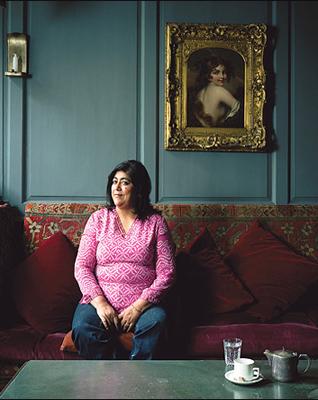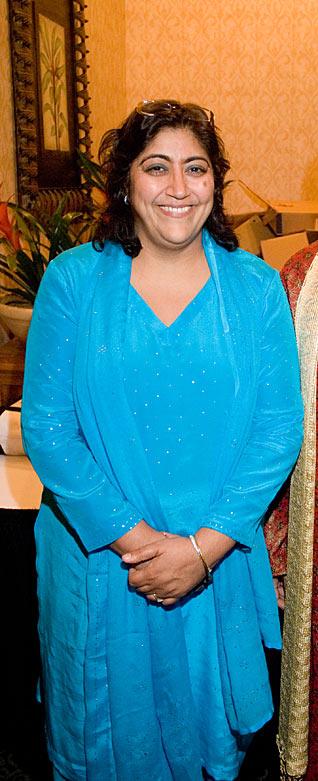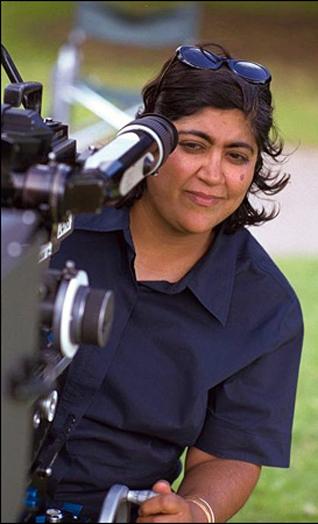Film/Stage
Gurinder Kaur Chadha: Who Do We Think We Are?
by SANGEETA KAUR LUTHRA
This past November, Gurinder Kaur Chadha, the Kenyan-born Sikh-Briton producer and director, was honored at the 40th International Film Festival of India by screening her entire repoirtore.
This month (Jan. 21-31) at the Sundance Film Festival, she will premiere her upcoming film, It's a Wonderful Afterlife, starring the magnificent Shabana Azmi.
It is wonderful to see Gurinder's skill as a movie director being recognized internationally. This is particularly important to me because of her focus on the stories of diaspora Sikhs.
Gurinder Chadha has been making films for many years, but she became a household name after the release of Bend it Like Beckham in 2002. There are probably very few movie-going Punjabis who haven't had the pleasure of viewing the film. This warm yet humorous rendition of a Sikh family that immigrated to Britain via East Africa, brings to the big screen the trials and triumphs of immigrant communities.
Unlike many other films about diaspora South Asians which tend to focus on the experience of alienation and loss, Gurinder's film is ultimately about a process of transplantation and spiritual and cultural growth.
The film's main character, Jessminder Kaur Bhamra, is an adolescent Sikh girl growing up in the upwardly-mobile suburb of Hounslow. Jessminder or "Jess" is an easygoing tomboy who spends her free time playing soccer and hanging out with the local Indian boys. Her parents, Mr. and Mrs. Bhamra, are preoccupied with making a living, educating their daughters, and preparing for the marriage of Jess' older sister, Pinky.
Through all this, Jess is dreaming of, almost communing with, the great soccer star and her idol, David Beckham.
By the end of the film, Jess is able to blend many priorities and resolve the conflict with her parents over her playing a "boys' game in shorts in front of hundreds of strange people," as her mother puts it. The film represents an interesting blend of cultural values: Jess develops her individual talent as a footballer and lands a scholarship to play in an American university; she successfully completes her A level exams; learns to cook a proper Punjabi meal - "meat and vegetarian" as her mother demands; and makes her somewhat jaded father proud by participating in her sister's wedding and respecting her family's wishes.
As a Times of India reviewer aptly put it, the film is really as much about bending social rules as it is bending (or curving) a football into a goal. This is because Gurinder Chadha wants us to think about how immigrants actually live in, not merely surviving, another country and culture. In particular, her camera lens zooms in on the lives of young people who out of necessity become ambidextrous negotiating two worlds and two cultures. Her stories layer multiple conversations - between immigrants and their native neighbors, immigrants and their families back home, and between immigrants and their children.
What emerges, often through a haze of alienation and conflict, is the generative and creative aspect of the diaspora experience.
Ironically, and effectively, Gurinder chooses to deal with such complex relationships by focusing on the proverbial kitchen table. Scene after scene the viewers witness mundane acts of everyday life crescendo into the zeitgeist of a community. This appreciation for the small things, her ability to paint people's everyday lives in epic forms, seems to be what gives Gurinder's work authenticity and depth. Thankfully, she tops all of this off with an essential masala: the humour.
The Early Years
Gurinder's career as a filmmaker began many years ago with a series of documentaries and short films.
In such films as I'm British, But ... (1989), A Nice Arrangement (1991), and the BBC series, Who do you think you are? (2006), she researches the changing identity of South Asian immigrants. In doing so, she looks at how these immigrants have to re-form or "translate" their social and cultural expectations to fit a new environment.
In, I'm British, But ..., Gurinder explores the rise of Bhangra music as a pop culture phenomenon in the U.K. Through a series of interviews with four young Asians all born and brought up in the U.K., she explores how they re-discover their roots through the performance and appreciation of Bhangra and Bhangra fusions. In the process, she suggests, not only did these Asian-British youth find a more comfortable place in their new home, but they helped articulate a new, multicultural identity for all British citizens.
Her conclusion is an obvious yet often obscured one: that immigrants don't merely adjust to a new environment, they shape it in meaningful ways.
In A Nice Arrangement, and later in her first feature film, Bhaji on the Beach (1993), Gurinder explores the question of marriage and women's choices in British Punjabi families. In these films, she looks at the difficulties of reproducing the arranged marriage system in a new land. Immigrant communities have to negotiate their old lives with new settings and often such settings in which their traditions are not supported by large networks of kin and community they left behind, which are often viewed by the outside society as ‘backward' and generally undesirable, and are eventually questioned and/or rejected by their own children.
A Search for Roots
Finally, in her episode of Who do you think you are? Gurinder Chadha presents the story of her family's journey from Punjab in 1917 to Kenya and then finally to England in the early 1960's.
Gurinder begins her story in Kenya where her grandfather had come to work as part of the massive wave of labor that moved through the British empire in order to fill the void that the abolition of the slavery had created. Whether they left their homes out of economic necessity or in search of opportunity and adventure, they all functioned within the colonial framework and were relegated to second class citizenship.
While in Kenya, Gurinder first visits the home and shop her grandfather, Sardar Bishen Singh, built by, and in which her father and his brothers and sisters were born. Of the three brothers, only her grandfather and his brother, Sardar Lakha Singh, remained. But Lakha Singh's story is murky because it was rumoured that he had married an African woman and had at least two children by her. Gurinder spends a good part of her time trying to find her long-lost African cousins. Although she never finds them, she exposes the uneasy race and social relations between Indians and Africans in the colonial hierarchy as well as in post-colonial Kenya.
Moving on to India, she visits the family of her grandfather's third brother who had gone back to India from Africa. She visits the places her grandmother and her father and his sisters stayed while they fought their way during the turbulent 1947 partition. She ends up in Pakistan visiting what is her ancestral home in the plains of the West Punjab from which her family originally hailed. The scenes and story feel epic and remind us of the history and social upheavals that shook so many people out of their villages and homes to new frontiers.
Looking to the Future
Gurinder Chadha's journey is one shared by so many millions of Sikhs and other Punjabis and South Asians who have moved around the globe over the last few generations - spurred on by changing political regimes or more recently by a new global economic order. The story of diaspora defines us not only in the terms of our economic needs and desire for more material things, but just as importantly in terms of our cultural creativity and the universally human impulse for contemplation, self-expression, and creation.
Immigrants are certainly not the only people to ask these questions about themselves or others. But certainly we ask them with a greater sense of urgency as we have left behind our homelands and the spaces that have for so long determined who we are.
Gurinder Chadha is a mesmerizing storyteller, crafting tales filled with savory mixtures of drama, emotion, irony and comedy. Obviously, she is not the only artist/ filmmaker to explore these questions. In fact there is such a large and rich body of film, music, literature, and art by and about the Sikh and South Asian diaspora that I wouldn't be able to do justice to here.
Instead I have focused on Gurinder here because of her special connection to the Sikh and Punjabi diaspora and her ability to cross-over to mainstream audiences.
Most of all I have been thrilled with Gurinder's ability to magnify and illuminate, and to prod and push us to really think about "who we are?" When we watch her films, we are given an opportunity to engage in a dialogue about questions of identity, tradition and modernity: Who are we? Where do we come from? Where are we going? How is our past connected to our future? I hope the readers of this will ask these questions of themselves - not out of despair or a sense of loss but in the spirit of ‘chardi kala' - the promise of what we can become, what we can create, and what we can share.
Readers can find out more about Gurinder Kaur Chadha's life and career at
http://www.screenonline.org.uk/people/id/502103/index.html
http://www.bbc.co.uk/history/familyhistory/get_started/ (search Gurinder Chadha - Who do you think you are?)
http://www.sawnet.org/cinema/?Chadha+Gurinder
January 14, 2010
Conversation about this article
1: Gurpal Singh (Wolverhampton, United Kingdom), January 14, 2010, 3:23 PM.
The documentary, 'Who Do You Think You Are?' was broadcast a few years back on prime-time British TV and was a fascinating piece of Sikh family history, where Gurinder traced her family roots in the Sikh community of Kenya and back further in the Potohari community of the Jhelum area (West Punjab). Her ancestors were in the Khalsa Army of Maharaja Ranjit Singh. An equally absorbing account was the programme on Meera Syal, whose Nana (maternal grandfather) was part of the Jaito Morcha in the 1920s. The programme showed original footage and in-depth history of the Jaito Morcha alongside a visit to the Sikh Museum at Darbar Sahib. Not sure whether sikhchic.com readers are aware that this last Sunday, BBC broadcast 'A Sikh Story' a one hour documentary about 1984 and the subsequent Sikh trauma.
2: Raj (Canada), January 15, 2010, 12:03 AM.
Aha ... but can she make 'Aloo Gobhi'?
3: Dr..Birinder Singh Ahluwalia (Toronto, Ontario, Canada), January 15, 2010, 8:03 AM.
I had the privilege of meeting Gurinder on a few occasions (both in Toronto and in sunny California). She is a happy person, full of energy and creative ideas. Her films portray these traits. My family and I must have seen Gurinder's "Bride and Prejudice" film numerous times. We all enjoyed it and laughed immensely every time. Congratulations, Gurinder, on your accomplishments. In particular, thank you for filming in Amritsar - "Guru di nagri" - my sweet home-town.
4: Gurmeet Kaur (Atlanta, Georgia, U.S.A.), January 15, 2010, 12:25 PM.
I enjoyed this lovely reading. You must see "What's cooking?" - (available on Netflix) to truly appreciate these words - "Ironically, and effectively, Gurinder chooses to deal with such complex relationships by focusing on the proverbial kitchen table." That's Gurinder alright! I can never get over how clever the fusion song "Marriage has come into Town" {Bride and Prejudice), filmed on the streets of Amritsar, is. It's simply brilliant!
5: Gurbilash Nagpaul (Port Orange, Florida, U.S.A.), January 23, 2010, 4:43 PM.
I know Gurinder chadha through her film, "Bend it like Beckam". I was quite impressed by her talents then, now further impressed by this well written article.
6: Mandip Kaur Sandher (Morriston, Ontario, Canada), May 11, 2010, 7:45 PM.
Great article. I would however, encourage all readers to further explore the term Sikh (Seeker of Truth). On my journey, I have experienced and opened up a whole new depth of the Universal Intelligence revealing many ancestral "connections". Is that not what we are here to discover as explorers of life. To find our connection to the whole, which would give us "membership" into the All That Is. What started my interest in this area was asking a simple question, WHY would Guru Nanak travel to the distant corners of the globe unless there was a deeper reason. The human race is ONE, but do we really FEEL the connection to the ONE, looking at everyone as a brother and sister, irrespective of colour or creed. We have to "experience this" and intuition and synchronicities have really helped me on my journey of life. Life is an exciting journey, make it worthwhile and let Life reveal to you the mysteries it is holding onto for your discovery.






